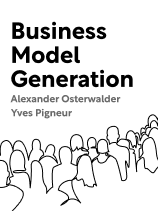

This article is an excerpt from the Shortform book guide to "Business Model Generation" by Alexander Osterwalder and Yves Pigneur. Shortform has the world's best summaries and analyses of books you should be reading.
Like this article? Sign up for a free trial here .
What are the nine elements of the Business Model Canvas? How are the elements related?
There are nine elements in the Business Model Canvas: 1) customer groups, 2) customer touchpoints, 3) customer interactions, 4) value proposition, 5) key resources, 6) network, 7) key activities, 8) revenue streams, 9) expenses. These elements are interdependent components that impact the effectiveness of the other elements. So, changes to one element can reduce or amplify the effects of other elements.
In this article, we’ll first briefly define what the Business Model Canvas is. Next, we’ll explore each of the nine overarching elements that you need to consider to create a successful business model.
What Is the Business Model Canvas?
Osterwalder and Pigneur developed a flexible template that they refer to as the “Business Model Canvas” to help you understand and focus on the nine overarching elements that they believe make up any successful business model. The template offers a visual framework to describe, assess, update, or design business models. You can use it to analyze the strategies of your competitors, to evaluate or to create new strategies for your existing business, or to design an entirely new business.
(Shortform note: The Lean Canvas is a popular adaptation of the Business Model Canvas. Developed by Ash Maurya, the author of Running Lean, it’s designed specifically for action-orientated start-up companies that rely on continuous experimentation to develop their products and services. Consequently, it places more emphasis on defining customer problems and identifying competitive solutions.)
The 9 Elements of the Business Model Template
Osterwalder and Pigneur encourage you to consider each of the nine Business Model Canvas elements as interdependent components that impact the effectiveness of the other elements. In other words, changes to one element can impose constraints or amplify the effects of other elements. Therefore, as you work on your business models, consider how you can leverage all of your elements to work together.
As you work on your business models, consider how you can leverage all of your elements to work together.
Element 1: Define Your Customer Groups
Define the different groups of customers your business intends to target—Osterwalder and Pigneur refer to this element as “Customer Segments.” You may serve one group of customers or several groups of customers depending on the needs you intend to fulfill. The authors state that your customers represent different groups if you need to:
- Create different products and services to meet their needs
- Reach them through different channels of distribution
- Develop different types of relationships with them
- Adapt your pricing structures to accommodate their needs
Once you’ve categorized your customers into distinct groups based on their needs or the way they interact with you, you can target these groups by designing your business model around their specific customer needs.
(Shortform note: The Four Steps to the Epiphany, by Steve Blank, emphasizes the importance of identifying and validating your customer groups before you develop your business model. The book includes a four-step customer development process to help businesses effectively define and target customer groups: 1) discover customers for your product or service, 2) validate your product and touchpoints, 3) create demand for your product or service, and 4) build strategies focused on customer management.)
Osterwalder and Pigneur argue that you need to approach each of your customer groups in specific ways when planning your business model. They provide the following examples of different types of customer groups:
Mass Market
For Mass Markets, the focus is on one large customer base with similar needs. Therefore, it isn’t necessary to distinguish between different customer groups when planning each of the other elements in your business model. For example, Colgate doesn’t need to differentiate its customers since toothpaste is an essential, widely-used personal care product. Therefore, Colgate can align all of its business model elements towards appealing to and engaging as many people as possible.
Niche Market
For Niche Markets, business models need to cater to specific customer groups and tailor each of the other elements to effectively target these specialized needs. For example, Lush targets customers who care about vegetarian products (no animal testing) and eco-friendly practices. Therefore, they align all of their business model elements to ensure the business focuses on environmentally friendly methods.
Subdivided Market
For Subdivided Markets, business models offer slightly different products and services to accommodate the needs of each of their customers. The way that they position each different product and service defines how they approach each of the elements. For example, an estate agent’s customers all want to buy or rent property. The estate agent can segment these customers into groups based on their income and on whether they wish to buy or rent. The higher the customer is willing to pay, the more emphasis the estate agent may have to put on developing customer relationships. This in turn affects the overall costs involved in targeting individual customer groups.
Diversified Market
Businesses that cater to two or more unrelated customer groups with different needs, have to base their business models around distinct products and services. All of the elements need to accommodate these distinct products and services. For example, Johnson & Johnson provides healthcare products and services to consumers. However, they also provide medical devices and equipment for hospitals. Johnson & Johnson has to target both of these customer groups separately to effectively cater to them.
Multi-Sided Market
Businesses that serve interdependent customer groups need to create products and services of equal value for each customer group. For the business model to function, each element needs to accommodate the full range of products and services on offer to both parties. For example, online marketplaces need to accommodate both buyers and sellers to operate efficiently—they can’t serve one group without the other group’s active participation.
Element 2: Define Your Touchpoints
Define your touchpoints, how you’ll communicate with your customers and deliver your products and services—Osterwalder and Pigneur refer to touchpoints as “Channels.” For your communication, sales, and distribution touchpoints, you have the option of using your own touchpoints (assets under your direct control such as your website or your store), or partner-owned touchpoints (external touchpoints that result from cooperation with marketing agencies or distribution partners), or a mix of both. In addition, the authors also make a distinction between direct touchpoints (communication you control such as your blog), and indirect touchpoints (communication you can’t control such as user reviews).
The authors state that there are five distinct stages to consider when defining your touchpoints:
- Advertise your products and services to customers
- Differentiate the value your products and services offer to customers
- Enable transaction processes so customers can buy your products and services
- Distribute your products and services to your customers
- Support customers after they’ve bought your products and services
Touchpoints and Interactions (Element 3) are closely linked—consider the level of interaction you want to have with your customers when defining your touchpoints.
| Businesses tend to assume that more touchpoints will lead to more customers, so they work hard to create multiple interaction points across the five stages. However, research indicates that too many touchpoints can reduce the quality of service that you deliver and damage customer experience. Customers care more about the quality of service you provide than what touchpoints you use—you’re more likely to create successful channels if you prioritize the development and integration of fewer interaction points. |
Element 3: Define Your Interactions
Define the type of interactions you want to establish for each of your customer groups—Osterwalder and Pigneur refer to this element as “Customer Relationships.” The authors advise that you consider what your motivations are for communicating with your customers as your approach will differ depending on whether you intend to acquire new customers, retain existing customers, or upsell to existing customers.
It’s important to note that the interactions customers have with your business deeply influence how they experience your products and services, so you need to carefully consider how you can meet their needs and create the right balance. The authors provide a list of ways to interact with your customers:
- Dedicated customer representatives for specific customers
- Customer representatives
- Self-service
- Automated services
- Communities and Forums
- Content co-creation
| Customers expect businesses to understand the relationships they want and to respond appropriately. However, despite spending billions trying to understand customer relationships, businesses often don’t understand these expectations and end up undermining their interaction efforts. Brand relationship experts have identified 29 different types of interactions that customers expect from a business—they use relationship metaphors such as “one-night stand” or “marriage” to clearly define each interaction. These experts argue that businesses can’t understand or leverage customer relationships unless they collect and analyze the relationship signals their customers send. |
Element 4: Define Your Value Offer
Define how you intend to offer value to these customers—Osterwalder and Pigneur refer to this element as “Value Propositions.” Your value offer outlines the benefits you intend to provide in the form of products and services. The authors state that successful value offers align with the needs of your customers and differentiate themselves from existing solutions.
When creating your value offer, consider these questions:
- Do you intend to disrupt the market with an innovative value offer, or do you intend to improve upon what’s already out there?
- What specific value do you intend to deliver to the customer?
- How will you adapt your value offer for each of your customer groups?
- What makes your value offer more appealing than that of your competitors?
(Shortform note: Osterwalder and Pigneur’s Value Proposition Design delves further into the topic of creating, testing, and improving your value offer.)
| Businesses often associate value creation with competition—they assume that they need to offer something that outperforms and displaces what’s currently on the market. However, Sesame Street, life coaching, and Viagra all prove that it’s possible to create innovative products and services without disrupting existing markets. Instead, the businesses behind these products and services bypass competition by focusing on creating demand in entirely new marketplaces. |
Element 5: Define Your Resources
Define what resources you need to create and deliver your products and services to your customer—Osterwalder and Pigneur refer to this element as “Key Resources.” According to the authors, you can own, lease, or acquire the resources you need. All resources fall into the following categories:
- Material: raw materials, buildings, factories, vehicles, and machinery
- Monetary: cash, credit, and stock options
- Intellectual: brand equity, copyrights, patents, and knowledge databases
- Human: experienced staff members and specialists
| Osterwalder and Pigneur suggest that you identify what resources you need to deliver your products and services—this method often highlights the need to acquire more resources before you can move forward with your business model. However, some businesses approach this in reverse: They use their resource limitations to inspire product and service innovations. For example, Southwest Airlines once had to sell one of their planes to avoid filing for bankruptcy. Instead of seeking additional resources, they confronted this new constraint (limited funds and limited planes) and sought a way to maintain their existing routes with fewer resources. Their shift in focus from “How can we get more resources?” to “How can we optimize our current resources?” led them to make changes that drastically improved their flight boarding processes. Southwest Airlines used its resource constraints to reposition its offering, differentiate itself from competitors, and become one of the most profitable airlines in the industry. This example emphasizes that you can create as much value from focusing on your resource limitations, as you can from acquiring new resources. |
Element 6: Define Your Network
Define the alliances you need to form to optimize your business model and increase market share, acquire resources, or reduce risk—Osterwalder and Pigneur refer to this element as “Key Partnerships.” In other words, what alliances will provide you with a sustainable competitive advantage and help you to grow quickly? The authors distinguish between four different types of alliances:
- Alliances between non-competitors (eBay and Paypal)
- Alliances between competitors (Apple and Microsoft’s patent-licensing agreement)
- Joint Alliances to develop new products and services (Ford and Toyota develop hybrid trucks)
- Buyer-supplier Alliances (Samsung supplies Apple)
(Shortform note: Innovation expert, Rosabeth Moss Kanter, author of Think Outside the Building, compares strategic alliance relationships to marriage—like marriage, many strategic alliances fail to live up to expectations. In other words, both suffer from a high failure rate. However, Kanter argues that strategic alliances are more likely to succeed if businesses focus on creating strong foundations built on shared values and mutual benefits.)
Element 7: Define Your Critical Actions
Define the core actions you need to take to operate successfully and meet customer demands—Osterwalder and Pigneur refer to this element as “Key Activities.” The authors state that your actions will fall into the following categories:
- Production: designing, manufacturing, and delivering products
- Troubleshooting: finding solutions to problems
- Infrastructure management: managing interactions between multiple applications and parties
(Shortform note: Osterwalder and Pigneur don’t provide practical advice here since different business models rely on different activities to operate successfully. Measure What Matters provides an effective goal-setting process that you can use to define the objectives (your end goal) and key results (how you will achieve your end goal) for each of your business model elements. For example, if you intend to manage platform interactions between different customer groups, your objective could be to acquire X number of customers in each group. Your key results could be: grow platform visitors by 5% every month, increase organic traffic by 10% every six weeks, and so on.)
Element 8: Define Your Profit Sources
Define how you intend to profit from the value you provide to your customers—Osterwalder and Pigneur refer to this element as “Revenue Streams.” The authors state that there are two types of income streams to consider, profits from single transactions, and profits from ongoing payments such as subscriptions. You may have multiple income streams for each of your customer groups. Further, each of these income streams may involve different pricing mechanisms depending on whether you choose to set a fixed or variable price for your products and services.
The authors include the following ways to generate profits:
- Selling physical products
- Charging a usage fee for a product or service
- Supplying services for subscription
- Leasing products and assets
- Licensing intellectual property
- Providing an intermediation or brokerage service
| How should you determine the price for your products and services? Many businesses determine their prices using the cost-plus method—calculate the costs involved and add on a percentage (desired profit). However, experts argue that businesses need to consider how much value customers attach to their products and services before they determine their prices. Further, businesses need to recognize that their customers perceive the value of their products and services in different ways depending on their specific requirements. If businesses build these variations into their pricing structure, they can expect to receive higher profits than they would with a single pricing policy. |
Element 9: Define Your Expenses
Define the expenses of operating all of the elements you’ve defined in your business model—Osterwalder and Pigneur refer to this element as “Cost Structure.” Your expenses will vary depending on whether you choose to minimize costs and offer an inexpensive product or service, or if you choose to create premium-priced products and services. The authors state that your costs structures will include at least one of the following characteristics:
- Fixed costs: salaries, rents
- Variable costs: costs vary in proportion to the volume of goods or services produced
- Economies of Scale: bulk purchase rates lessen cost per unit rates
- Economies of Scope: a single resource or activity supports multiple operations or services
| All of your costs will also fall into the following categories: Direct costs: specific expenses related to your business model elements such as paying to manufacture your product Indirect costs: general costs that keep your business operating such as paying rent, utilities, and salaries. Knowing the difference between these costs will help you to identify your overall business expenses. |

———End of Preview———
Like what you just read? Read the rest of the world's best book summary and analysis of Alexander Osterwalder and Yves Pigneur's "Business Model Generation" at Shortform .
Here's what you'll find in our full Business Model Generation summary :
- The nine elements that make up any successful business model
- Different ways you can combine these elements to create business model patterns
- Techniques you can use to generate innovative ideas






